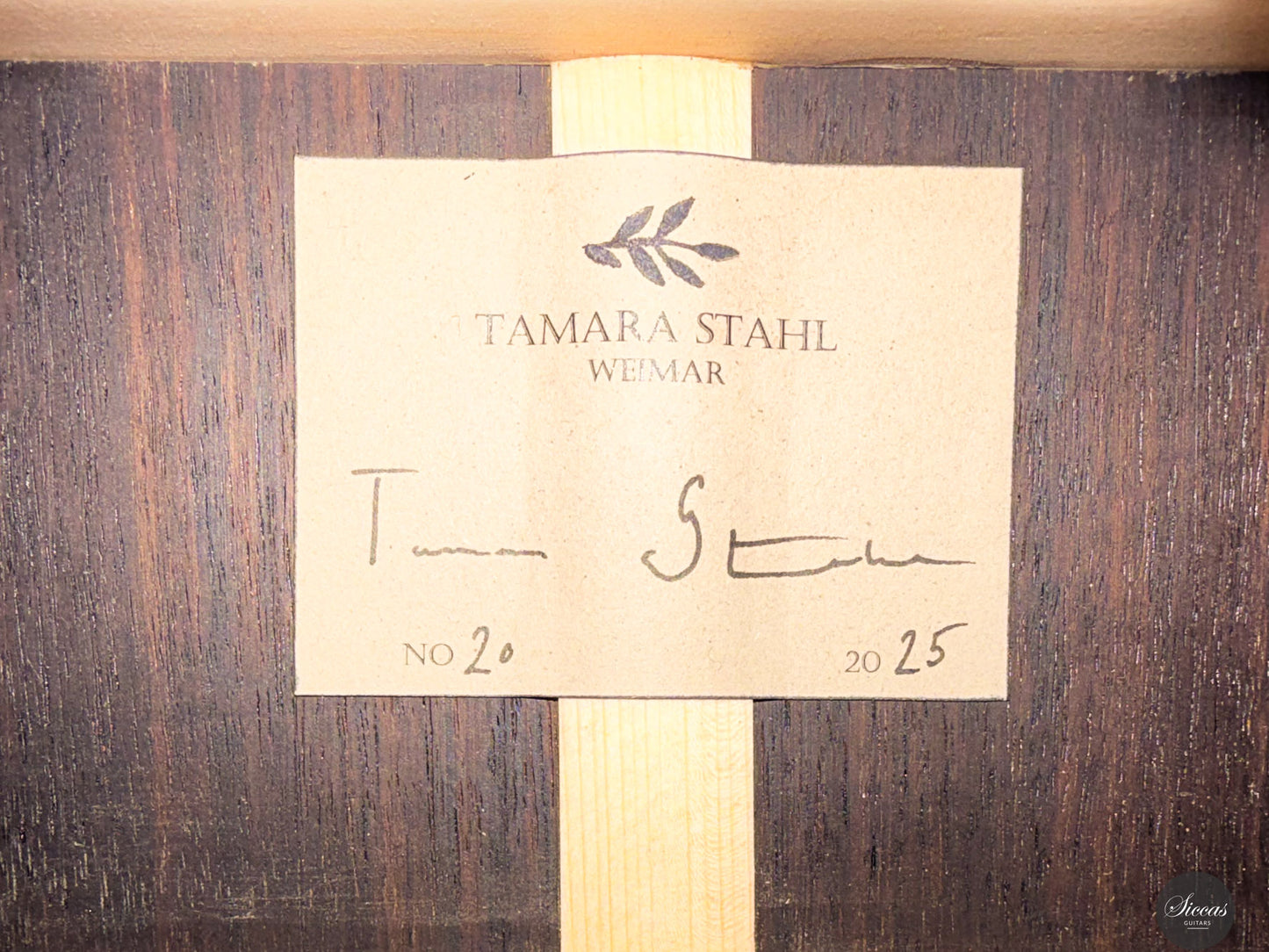Tamara Stahl - 2025 No.20
Tamara Stahl - 2025 No.20
Details
Details
Overview
Overview
Shipping important note
Shipping important note
Delivery times are typically reliable and most instruments arrive within the estimated timeframe.
Should any unexpected delay occur, our team will keep you informed and provide support at every step. For all shipping details and exceptions, please see our Shipping Policy.
Details about GPSR
Details about GPSR

























Video overview


More details about the guitar
About the luthier
Tamara Stahl began her path in guitar making in 2016 during her time at Siccas Guitars in Karlsruhe. Experiencing a large range of handcrafted instruments awakened her interest in how construction details shape the voice and feel of a guitar. In 2019 she graduated from the instrument making school in Mittenwald and continued her studies by moving to southern Spain where she learned from experienced makers in the region often regarded as the birthplace of the modern classical guitar. Since 2022 she has been working in Weimar where she shares a workshop with the luthier Johanna Vogl. This environment supports an exchange of ideas while allowing each maker to follow an independent artistic direction.
Her guitars are known for precision, refined visual design and a sound that joins traditional sweetness and clarity with the strength and projection expected in modern concert instruments. Stahl develops her building system through careful incremental adjustments. In every new guitar she seeks a balance of resonance, structural stability and expressive potential.
About the guitar
This instrument from 2025 with the number 20 reflects the evolution of Tamara Stahl’s mature building style. It is constructed in a traditional manner with a cedar top and Indian rosewood body, finished throughout with French polish. The doubled sides and the carefully weighted bridge contribute to increased projection and stability. The overall build feels compact and solid while remaining sensitive to the lightest touch. Kris Barnett tuning machines provide smooth and steady tuning.
The guitar produces a tone that is airy and full bodied. The character is slightly dark yet always open and round. The notes carry a noticeable weight and the sound has an appealing sense of depth. The instrument responds quickly across all registers and sustains with ease. The trebles are clear and smooth and the basses are present and supportive without dominating the texture. The result is a guitar that blends the intimacy found in traditional instruments with the headroom needed for concert playing. It encourages expressive shaping of lines and offers a wide range of colours with subtle gradations of tone.
Regular care extends the life of the instrument
Even with careful use, a classical guitar may gradually change in appearance or respond to unstable storage conditions. Have a close look at your guitar regularly and be attentif to changes. If your instrument is suffering from its environement, it will let you know.
Protect Your Guitar: Handle with Care
Be mindful when touching your instrument with greasy or unwashed hands: any skin contact is a small attack on the varnish. Of course, a guitar is made to be played, but taking a few precautions helps preserve its beauty: wash your hands before playing, wear long sleeves, and avoid unnecessary direct skin contact with the body of the instrument.
Pro tip: Avoid playing with a button-up shirt, heavy jewelry, or a belt, as these can scratch the guitar. Also, make sure your guitar case is free of any objects that could damage the instrument during storage.
String care
A good habit to adopt is wiping down your strings briefly after each playing session. This small action significantly extends their lifespan and helps maintain a consistent, comfortable feel under your fingers.
Most importantly, clean strings are essential for keeping your instrument in tune. Corrosion, sweat, and dust can affect the uniformity of the strings and interfere with accurate tuning across the entire fingerboard.
Pro tip: If you're having trouble getting your guitar in tune, it might be time to change the strings. A useful test is to compare the pitch of the 12th fret harmonic with the fretted note at the 12th fret; if there's an unusually large gap between them, your strings may have lost their integrity and should be replaced.
Keep Your Shellac Finish Shining!
Got a guitar with a shellac (French polish) finish? Here's a simple trick: Take a clean microfiber cloth and gently breathe on the surface to create a light mist. Then, softly rub to remove fingerprints, sweat, and grease. That’s usually all it takes to keep it looking great, no products needed!
Pro tip: Every few years, treat your guitar to a check-up with a luthier to keep it in top shape.
Storing Your Guitar: Climate Matters
Your guitar can safely stay outside its case, as long as the surrounding environment maintains 42–55% humidity and a temperature between 18–25°C.
Keep in mind that humidity levels can still fluctuate inside the case, especially during seasonal changes.
- Too much humidity may cause overtightened strings and a dull tone.
- Too little humidity can lead to a bulging top, string buzz, or even cracks.
Avoid placing your guitar near radiators, air conditioners, or windows with direct sunlight.
Pro tip: Always close your guitar case while playing. This helps preserve a stable microclimate inside the case, so your instrument is protected the moment you put it back in.

























































